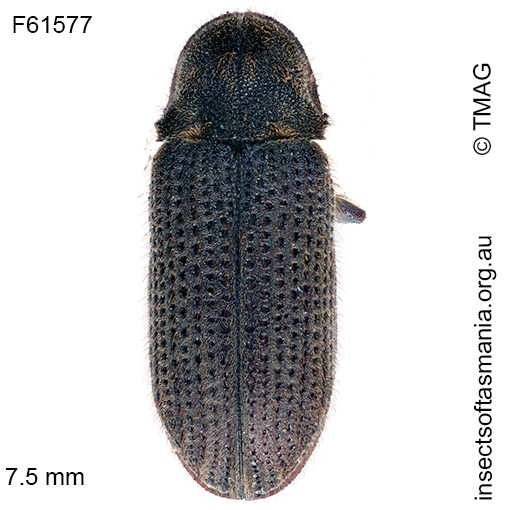
Hadrobregmus areolicolle (Lea, 1924) (a species of furniture-beetle)
Basis for Tasmanian occurrence
Classification
Suborder: Polyphaga
Superfamily: Bostrichoidea
Family: Ptinidae
Subfamily: Anobiinae
Tribe: Hadrobregmini
Morphology
Typical length (mm): 7.5
Flightedness: winged and assumed capable of flight
Source literature on morphology and taxonomy (*primary taxonomic source, where identified):
Español, F. (1976). Contribución al conocimiento de los Anobium y generos afines de Australia y Nueva Zelanda (Col. Anobiidae, nota 71). Misc. Zool. 3 (5): 141-160.
*Lea, A.M. (1924). On Australian Anobiides (Coleoptera). Trans. Roy. Soc. S.A. 48: 15-64.
Ecology
Association with dead wood or old trees: obligately saproxylic
Ecological attributes: — Nothofagus cunninghamii is a host-plant (Bashford, 1990a) — May occupy logs or trunks of Eucalyptus obliqua, at least temporarily, since found having emerged within a year of felling (Grove & Bashford, 2003) — May occupy logs or trunks of Eucalyptus obliqua, at least temporarily, since found having emerged within six years of felling (Grove et al., 2009).
Collection method(s) for TFIC material: — At light (with use of light-trap) — Baited trapping (funnel trap) — Emergence trapping from log (host not specified) — Emergence trapping from log of Eucalyptus obliqua — Flight intercept trapping (trough below Malaise trap) — Hand collection (substrate not specified) — Hand collection from under bark (tree species not specified) — Knockdown fogging of canopy of Nothofagus cunninghamii — Log-mounted flight intercept trapping — Malaise trapping — Panel trapping — Pipe trapping — Pitfall trapping — Rearing in insectary from Nematolepis squamea — Sticky trapping (substrate not specified) — Sticky trapping on Acacia melanoxylon — Sticky trapping on Eucalyptus obliqua — Trapping using a range of devices placed in crown of Eucalyptus obliqua (Bar-Ness, 2005) — Trunk window trapping (Harrison, 2007) — Vane trapping.
Source ecological literature:
Grove, S.J. & Bashford, R. (2003). Beetle assemblages from the Warra log decay project: insights from the first year of sampling. Tasforests 14: 117-129.
Grove, S.J. (2009b). Beetles and fuelwood harvesting: a retrospective study from Tasmania’s southern forests. Tasforests 18: 77-99.
Bar-Ness, Y. (2005). Crown structure and the canopy arthropod biodiversity of 100 year old and old-growth Tasmanian Eucalyptus obliqua. Msc thesis, Univ. of Tasmania, Hobart.
Bar-Ness, Y.D. et al. (2006). Age and distance effects on the canopy arthropod composition of old-growth and 100-year-old Eucalyptus obliqua trees. For. Ecol. Manage. 226: 290-298.
Bashford, R. (1990a). Tasmanian forest insects and their host plants: records from the Tasmanian Forestry Commission insect collection. Hobart: Tas. Forestry Commission, 32 pages.
Grove, S. et al. (2009). A long-term experimental study of saproxylic beetle … succession in Tasmanian Eucalyptus … logs… In: Fattorini, S. (Ed.), Insect Ecology and Conservation. Research Signpost, pp. 71-114.
Harrison, K.S. (2007). Saproxylic beetles associated with habitat features in Eucalyptus obliqua trees in the southern forests of Tasmania. PhD thesis, Dept. of Zoology, Univ. of Tasmania, Hobart.
Yee, M. (2005). The ecology and habitat requirements of saproxylic beetles native to Tasmanian wet eucalypt forests: potential impacts of commercial forestry practices. PhD thesis, Univ. of Tasmania, Hobart.

